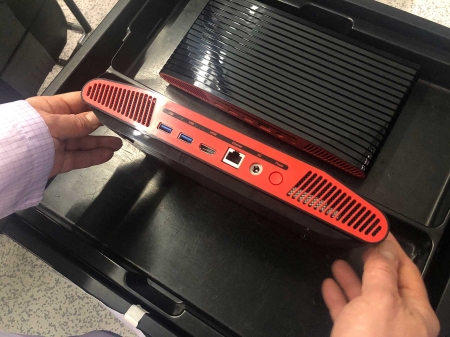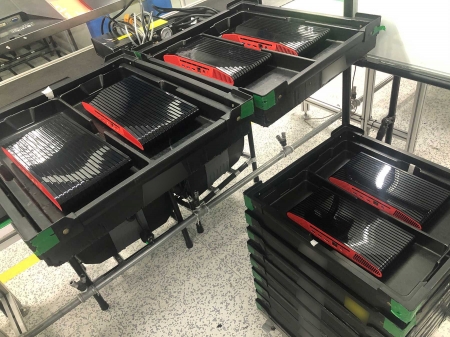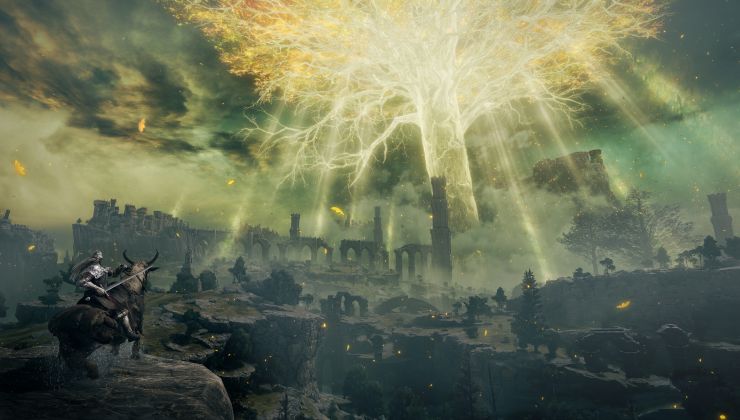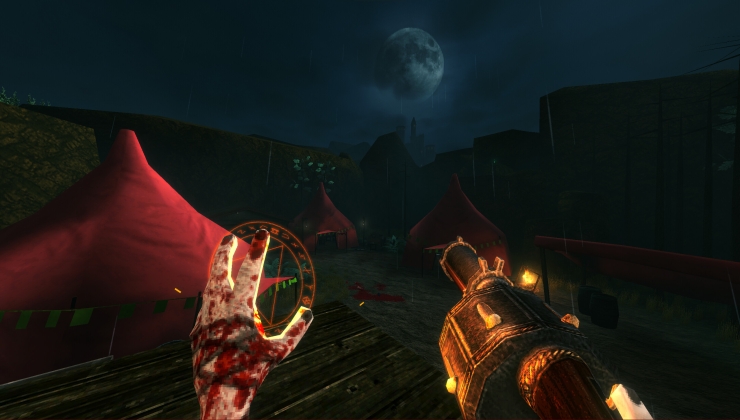Ah yes, Atari VCS, the delayed Linux-powered gaming box that was crowdfunded on IndieGoGo. It's still a thing and the team seem to think it's all going well.
In a new development update on the Atari VCS Medium account, the team posted a set of questions and answers from the COO Michael Arzt as to what's been happening recently. This follows on from the news back in October, where their system architect Rob Wyatt quit citing non-payment.
From the post they said they're currently going over the hardware to test "for functionality and reliability" and doing tweaks as needed, as then design and engineering teams recently went over to visit their partners in China who are building the actual Atari VCS units along with some photos:
Also detailed in the Q&A post is that they're developing the UI and store in the Unity game engine and they say it's "almost complete". Unity are apparently working closely with them on this, and they have "several studios" lined up ready for the Atari VCS launch. They're not saying who or what games though.
For streaming services like Amazon, Netflix and so on, it does sound like they will not have dedicated applications for them. Not yet anyway, they said for such service there will be the choice of viewing them through a web browser and that "the first big wave of apps isn’t likely to come before Q1".
When talking about the Atari OS, they confirmed yet again it's based on a "Linux foundation" with their integrated Atari VCS store and the Sandbox Mode will be available for installing and booting more traditional operating systems, like a standard Linux distribution (or Windows) so you could boot up Steam on it if you wanted.
IndieGoGo backers were supposed to be getting their units before the public release in December this year. That is now being delayed, although they claim "we are talking weeks here, not months, and the Indiegogo backers remain our top priority".
According to the post, they are on schedule for a full release in March 2020. Let's see what happens.
Quoting: tuubiQuoting: ShmerlOnly HDMI output? That's a huge no go. At least they should use both DisplayPort and HDMI, if they think HDMI is so necessary.Plenty of TV sets with no DP inputs, but all of them have HDMI. I doubt this is such a no-go for most of their target audience.
"HDMI only" is also bad for us old-timer "purists" who remember (and still have) the original Atari (2600) VCS, but in another direction: HDMI is too *new!* :-D I'd like to see this thing output analog composite video just like the classic Atari 2600, or VGA at the absolute newest. (Strictly speaking, I consider even VGA "cheating," from the purist standpoint -- but realistically that's the type of monitor _I_ have the most of! ;-) I don't insist on *modulated RF, broadcast-TV* output, mainly because I was able to tap into my classic VCS "upstream" of the modulator and pull out video, directly, "so, it *counts!*" ;-) )
In any case, I expect some degree of geometric distortion when playing games designed for analog composite screens on any kind of HD screen; there's no tidy conversion factor to deliver crisp analog pixels across a full-width HD screen. (As evidence, displaying analog composite video from my PS2 to a $2000+ Sony Bravia TV is really crappy: in-game text, in particular, is all but completely unreadable.) My suggestion would be to use only part of the HD screen and present composite-video-wannabe displays only at exact multiples of composite-video standard dimensions. Please tell me someone thought about this during design, and took steps to address it.
That said, I have to admit that this is the first I've heard of this project, so maybe I'm misunderstanding what it's supposed to do. I'm thinking I could quickly achieve the same thing with an OrangePi multi-emulator machine -- which has already existed for a while now -- mounted in a classic Atari 2600 *case* for the sake of nostalgia. But maybe this project adds something more ...?
Quoting: slaapliedjeYeah, unless you want to use this as a cheap computer, why would you need DisplayPort? Not a single game console out there has it.
That's not an excuse to follow the bad practice.
Quoting: TheRiddickI think you can use a HDMI to Displayport dongle?
That's not possible. You can convert DP to HDMI, but not the other way around, due to DP being a lot more complex. That's another reason to prefer DP output everywhere - if needed, you can convert it to every other possible display signal, while the other way around is not going to work.
Last edited by Shmerl on 1 December 2019 at 7:03 am UTC
Quoting: ShmerlOf course it's possible, but the "active" adapters are much more expensive than DP to HDMI ones.Quoting: TheRiddickI think you can use a HDMI to Displayport dongle?
That's not possible. You can convert DP to HDMI, but not the other way around, due to DP being a lot more complex.
Quoting: tuubiOf course it's possible, but the "active" adapters are much more expensive than DP to HDMI ones.
Last time I looked for one, it wasn't possible. Do you know any examples?
Last edited by Shmerl on 1 December 2019 at 9:05 am UTC
Quoting: ShmerlQuoting: tuubiOf course it's possible, but the "active" adapters are much more expensive than DP to HDMI ones.
Last time I looked for one, it wasn't possible. Do you know any examples?
Does this match?
https://www.amazon.com/-/de/dp/B07G796JF8/ref=mp_s_a_1_5?keywords=hdmi+to+displayport+adapter&qid=1575191928&sr=8-5
Quoting: EikeDoes this match?
Yes, looks like it's generating DP from HDMI output. I guess they built some kind of processor or controller into the cable, it can't be a simple conversion.
Last edited by Shmerl on 1 December 2019 at 9:37 am UTC
Quoting: ShmerlI think that's why they call them active adapters, as opposed to passive ones.Quoting: EikeDoes this match?
Yes, looks like it's generating DP from HDMI output. I guess they built some kind of processor or controller into the cable, it can't be a simple conversion.
Quoting: MohandevirQuoting: NeverthelessQuoting: MohandevirQuoting: NeverthelessQuoting: MohandevirGoogle Stadia... Atari VCS... I still wonder if we'll ever see a Linux gaming system that starts with a "Bang! Nailed it!".
It's not impossible... Sony's Playstation is similar to a BSD platform... They did it.
They did it because they could legally own the underlying pre-existing operating system, and because it's relatively easy to support uniform hardware of dedicated vendors with drivers. It did not help people wanting to play games on their BSD boxes.
To support Desktop Linux means wanting to support open gaming on a wide variety of hardware and drivers.
Totally... Still, I'm wondering what would have happened if Valve decided to go all in in the Console market with a Steam Machine initiative like Microsoft's Xbox. I mean, with a dedicated Steam Machine store that's a subset of what you may find in the desktop client (100% Linux/Proton and controller supported titles only) and optimized for the Steam Machine (dedicated hardware built by Valve)... But the games you buy on the Steam Machines' store are then available and synced on any other desktop clients...
Well we'll never know, I guess...
Maybe Valve is sort of "all in" already. The question is what they want to achieve.
I think you have to look at the revenue side and the expenditure side. Someone who wants to market a closed console system like XBox, has to spend money to solve a manageable technical problem. The more defined the hardware and OS to be supported, the smaller the amount of money needed. Much more money is needed to get developers to support the console with games and to establish the platform on the market. In return, the owner of the platform earns an exclusive share on the software, while the hardware is often sold at a loss in the beginning.
Valve seems to pursue (or have to pursue) the exact opposite goal with its Linux initiative. An open system consisting of various hardware and OS variants, which even starts the (partly outdated) software of other platforms, sometimes even coming from other distribution platforms. It is the approach which needs the biggest technical effort, but has the advantage of lots of existing software. They get money for all they sell on the Steam shop and support the software they already sold. The Steam Machine plus Steam Controller could have been an attempt to standardize the hardware and the controller concept. This didn't work very well, baybe partly because the Steam Machines weren't nessessary to use the software.
I also see the VCS as a kind of in-between thing with a uniform controller concept for Atari retro software and the possibility for other more open uses, which probably will be very limited considering the performance of the hardware, and from which Atari won't earn anything or at least not much.
You got my point. Thing is Valve tried a "middle" solution that resulted in a confusing offer... Was it to bring PC gamers to the console market, or console gamers to the PC market? They failed at both. Nobody knew who it was for.
I think it could have been possible to create a pure Linux based console (SteamOS, remember?), based on one or two sets of x64 PC hardware built by Valve (Just like the Atari VCS) and support the PC market as two separate offers, that would benefit both, software side (it's all open source afterall); one for the console gamers and one for the PC gamers. Yes, it requires more investments and that's what I would have liked to see. More investments also means more determination.
This said, don't get me wrong, Valve is doing awesome things for Linux on the desktop and I'm really thankful for that, but for the Steam Machine thing, they seem to have got it off the door, and never looked at it again. Like they knew, from the start, that it would fail. Just maintaining SteamOS looked like it became a burden, early on.
But I'm no insider and I don't want to underestimate the work of anyone. The guys who worked directly on the project have all my admiration (PLGriffais, Timothee Besset, JVert and others I can't remember)... It's just my impressions.
My point is: If Valve did create an open console with a narrow set of hardware and just 64bit Linux, then most pre existing software on Steam would not run on it, and the software made for this platform would not nessessarily run on existing Steam-users Linux boxes. I don't think such a platform would take off any more than Steam Machines did.










See more from me